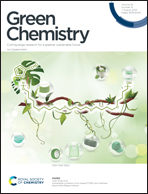Ultrahigh stable covalent organic framework-derived carbon–nitrogen-supported palladium nanoparticles for highly efficient electrocatalytic methanol and ethanol oxidation reactions
Abstract
Direct methanol and ethanol fuel cells are important components of the development and application of emerging contemporary energy carriers. However, most electrocatalysts used in the methanol oxidation reaction (MOR) and ethanol oxidation reaction (EOR) have very limited durability. Herein, a strategy for Pd2+ loading on a specific covalent organic framework (COF) by impregnation is disclosed. Then, high-temperature carbonization is used to convert it into a COF-derived nitrogen-doped carbon (CN) to obtain a series of Pd–CN catalysts with different Pd loadings. Among them, Pd–CN-2 (with 2.51 wt%) exhibits high activity in the MOR and EOR. Its activity in the MOR is 2.93 A mgPd−1 (much more active than Pd/C-0.20 A mgPd−1). In the EOR, it reached 5.44 A mgPd−1, 25 times higher than that of Pd/C (0.22 A mgPd−1). In addition, the catalyst shows superior stability in both the MOR and EOR, maintaining more than 90% of its initial mass activity after a 40 000 s stability test. Its high activity and stability are probably attributed to the extraordinary stability of COF-derived CN materials and the interaction between Pd and CN. This work provides a general synthesis idea of obtaining highly efficient and stable metal–carbon–nitrogen electrocatalysts for application in fuel cells.



 Please wait while we load your content...
Please wait while we load your content...